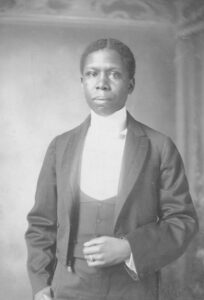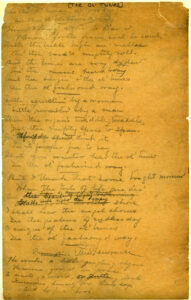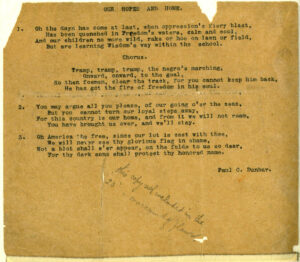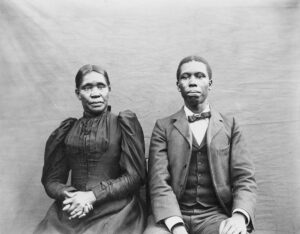“He Sang of Life” — The Writing of Paul Laurence Dunbar

Paul Laurence Dunbar (1872-1906) was an Ohioan of distinction and determination. A prolific writer, he published poetry and fiction to great acclaim, making him the first Black American to earn a living from writing. Having been born just one generation removed from enslavement, he overcame obstacles and achieved heights of which many of his contemporaries could only dream.
Dunbar once said “I hope there is something worthy in my writings and not merely the novelty of a black [sic] face associated with the power to rhyme that has attracted attention.” And because Dunbar’s words will always be “worthy,” we are choosing to focus on his writing for his 150th birthday, rather than his life story. It’s through his writing that we see a “significant representation of African American life at the turn of the twentieth century” (Paul Laurence Dunbar Biography, Wright State University; website linked below). By the way, for those who would like to read more about his life, we’ll link to some sources at the end of this post.

While Dunbar may not have been seen as the novelty he feared himself to be — indeed, he was largely beloved in his lifetime — the color of his skin, and the way he used vernacular (also known as “Negro Dialect” or “or African-American Vernacular English”) to portray Black voices, have led some to label him in harsh terms, calling him “self-hating,” or accusing him of bowing to racism (Stanford News, Stanford University; website linked below). These labels are generally seen as inaccurate by modern scholars – more on that later – but Dunbar appears to have felt some pressure to write in vernacular in order to appeal to a wider audience. After his death, poet and author (and friend of Dunbar) James Weldon Johnson quoted him as saying “I’ve got to write dialect poetry; it’s the only way I can get them to listen to me” (Johnson, James Weldon; Book of American Negro Poetry, linked below). He may have been correct; Dunbar’s first, self-published book of poetry, Oak and Ivy, didn’t generate the excitement and popularity of Majors and Minors, his work that featured poetry in standard English and vernacular.
Evidence shows, though, that Dunbar knew that navigating the world successfully as a Black man required a performance. Today, this is called “code-switching” and it involves adjusting one’s behaviors, including speech, to optimize the comfort of others in exchange for fair treatment; writing in vernacular satisfied an expectation from a readership that had the power to grant him success. His poem, “We Wear the Mask,” addresses this quite clearly:

We wear the mask that grins and lies,
It hides our cheeks and shades our eyes,-
This debt we pay to human guile;
With torn and bleeding hearts we smile,Why should the world be over-wise,
In counting all our tears and sighs?
Nay, let them only see us, while
We wear the mask.We smile, but, O great Christ, our cries
To thee from tortured souls arise.
We sing, but oh the clay is vile
Beneath our feet, and long the mile;
But let the world dream otherwise,
We wear the mask!
In 2006, in observation of the anniversary of Dunbar’s death from tuberculosis at the age of 33, Stanford University hosted the Paul Laurence Dunbar Centennial Conference (report linked below), gathering scholars to use a modern lens to reexamine the author’s works. The consensus was overwhelmingly positive: Dunbar was “a central figure in American literature and modernism.” According to poet Joann Braxton, “Critics of Dunbar’s failure to forthrightly address such questions as the unfair treatment of black soldiers in the Civil War (Dunbar’s father served in the Union Army) were missing what alternatively could be read as Dunbar’s strategic silences and negotiations with [a 19th-century] audience that in large part didn’t want to know too much.” With regards to his dialect poetry, Joanne Gabbin, professor of English from James Madison University, said they were, “for him, portraits of those who survived the devastating institution of slavery with their humanity intact,”

As of this writing, Dunbar’s birthday, June 27, is just a few days away. We would like to honor this remarkable man by sharing those written works, including unpublished poetry, that are available in Ohio Memory. First, though, consider using this glossary of dialect terms, developed by the University of Dayton, as you read through poems written in vernacular. While you will likely be able to read the words and understand their meaning by the context in which they’re used, hearing the word spoken by Dunbar scholar Herbert Woodward Martin brings them to life in all their richness and beauty. You’ll find a selection of materials, including photographs, here. You might start with “When Malindy Sings,” an ode to Dunbar’s mother, Matilda, and then listen to it being read here (note: clicking the link will take you to a site not affiliated with Ohio Memory). For another selection written in vernacular, see Songs of Cabin and Field, a collection of poetry by Dunbar set to music written by Evelyn McCue Wright. And be sure to look at Dunbar’s botanical sketchbook, likely from his days at Central High School in Dayton, and the photo of his graduating class, where you’ll see another famous Daytonian and friend of Dunbar: Orville Wright. Finally, spend some time with Majors and Minors, the collection of poetry that launched Dunbar to fame and that contains “We Wear the Mask,” transcribed above; the “majors” in this title are in standard English, while all of the “minors” are in vernacular. Finally, you can also visit the home Dunbar shared with his mother in Dayton and see many of his personal belongings as well as his literary treasures.
Further Reading:
africanamericanpoetry.org: Paul Laurence Dunbar biographical sketch
James Weldon Johnson: Book of American Negro Poetry, available for free via Project Gutenberg
Robinson, Lillian S.; Robinson, Greg: “Paul Laurence Dunbar: A Credit to His Race?,” African American Review, Summer 2007
Palmer, Barbara. “Centennial conference re-evaluates legacy of writer, Paul Laurence Dunbar.” Stanford Report, 2006.
Wright State University: “Paul Laurence Dunbar;” 2022.
Birkhimer, Lily. “’New’ Dunbar Poems!” Ohio Memory Blog. March 9, 2012.
Thank you to Shannon Kupfer-Trausch, Digital Initiatives Librarian at the State Library of Ohio, for this week’s post!



Leave a Reply
You must be logged in to post a comment.